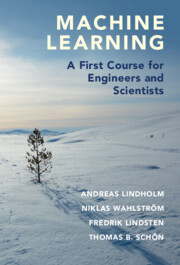Refine search
Actions for selected content:
6829 results in Communications and signal processing
3 - Catastrophes, Conspiracies, and Subexponential Distributions
- from Part I - Properties
-
- Book:
- The Fundamentals of Heavy Tails
- Published online:
- 17 May 2022
- Print publication:
- 09 June 2022, pp 56-84
-
- Chapter
- Export citation
Appendix B - GSP with Matlab: The GraSP Toolbox
-
- Book:
- Introduction to Graph Signal Processing
- Published online:
- 09 May 2022
- Print publication:
- 09 June 2022, pp 253-285
-
- Chapter
- Export citation

Machine Learning
- A First Course for Engineers and Scientists
-
- Published online:
- 27 May 2022
- Print publication:
- 31 March 2022
-
- Textbook
- Export citation
Part II - How Does PLC Perform?
-
- Book:
- A Practical Guide to Power Line Communications
- Published online:
- 05 May 2022
- Print publication:
- 19 May 2022, pp 119-120
-
- Chapter
- Export citation
Contents
-
- Book:
- A Practical Guide to Power Line Communications
- Published online:
- 05 May 2022
- Print publication:
- 19 May 2022, pp v-viii
-
- Chapter
- Export citation
2 - The PHY Layer of PLC
- from Part I - How Does PLC Work?
-
- Book:
- A Practical Guide to Power Line Communications
- Published online:
- 05 May 2022
- Print publication:
- 19 May 2022, pp 17-49
-
- Chapter
- Export citation
Part I - How Does PLC Work?
-
- Book:
- A Practical Guide to Power Line Communications
- Published online:
- 05 May 2022
- Print publication:
- 19 May 2022, pp 15-16
-
- Chapter
- Export citation
3 - The MAC Layer of PLC
- from Part I - How Does PLC Work?
-
- Book:
- A Practical Guide to Power Line Communications
- Published online:
- 05 May 2022
- Print publication:
- 19 May 2022, pp 50-77
-
- Chapter
- Export citation
4 - Experimental Framework
- from Part I - How Does PLC Work?
-
- Book:
- A Practical Guide to Power Line Communications
- Published online:
- 05 May 2022
- Print publication:
- 19 May 2022, pp 78-118
-
- Chapter
- Export citation
Preface
-
- Book:
- A Practical Guide to Power Line Communications
- Published online:
- 05 May 2022
- Print publication:
- 19 May 2022, pp ix-x
-
- Chapter
- Export citation
Frontmatter
-
- Book:
- A Practical Guide to Power Line Communications
- Published online:
- 05 May 2022
- Print publication:
- 19 May 2022, pp i-iv
-
- Chapter
- Export citation
7 - Security in PLC
- from Part III - Management, Security, and Further Applications
-
- Book:
- A Practical Guide to Power Line Communications
- Published online:
- 05 May 2022
- Print publication:
- 19 May 2022, pp 199-220
-
- Chapter
- Export citation
Index
-
- Book:
- A Practical Guide to Power Line Communications
- Published online:
- 05 May 2022
- Print publication:
- 19 May 2022, pp 243-248
-
- Chapter
- Export citation
5 - PHY-Layer Performance Evaluation
- from Part II - How Does PLC Perform?
-
- Book:
- A Practical Guide to Power Line Communications
- Published online:
- 05 May 2022
- Print publication:
- 19 May 2022, pp 121-149
-
- Chapter
- Export citation
6 - MAC-Layer Performance Evaluation
- from Part II - How Does PLC Perform?
-
- Book:
- A Practical Guide to Power Line Communications
- Published online:
- 05 May 2022
- Print publication:
- 19 May 2022, pp 150-196
-
- Chapter
- Export citation
Part III - Management, Security, and Further Applications
-
- Book:
- A Practical Guide to Power Line Communications
- Published online:
- 05 May 2022
- Print publication:
- 19 May 2022, pp 197-198
-
- Chapter
- Export citation
9 - Conclusion
- from Part III - Management, Security, and Further Applications
-
- Book:
- A Practical Guide to Power Line Communications
- Published online:
- 05 May 2022
- Print publication:
- 19 May 2022, pp 239-242
-
- Chapter
- Export citation
Abbreviations
-
- Book:
- A Practical Guide to Power Line Communications
- Published online:
- 05 May 2022
- Print publication:
- 19 May 2022, pp xi-xvi
-
- Chapter
- Export citation
1 - Introduction
-
- Book:
- A Practical Guide to Power Line Communications
- Published online:
- 05 May 2022
- Print publication:
- 19 May 2022, pp 1-14
-
- Chapter
- Export citation
8 - Heterogeneous Networks and IEEE 1905
- from Part III - Management, Security, and Further Applications
-
- Book:
- A Practical Guide to Power Line Communications
- Published online:
- 05 May 2022
- Print publication:
- 19 May 2022, pp 221-238
-
- Chapter
- Export citation
